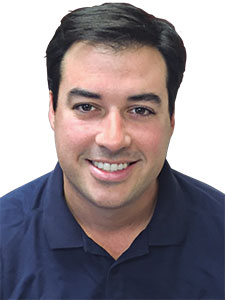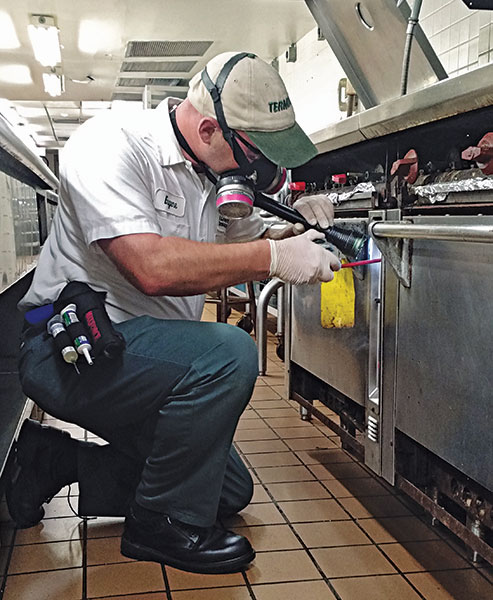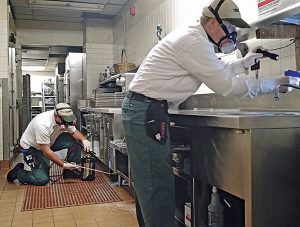Cockroach treatment for commercial restaurant accounts requires a little something extra.
The public, as well as your commercial customers, is never happy to see a cockroach. But beyond seeing, no one even wants to think about cockroaches in places where food is served and prepared.

Joe Martin
Joe Martin, entomologist for Terminix Service Co., Metairie, La., is an expert at managing German cockroaches. That’s thanks to years of experience servicing commercial accounts — many of which are restaurants and other eating establishments.
There are several obvious differences between servicing a private home and a commercial account, he says, and those differences are magnified by the conditions a German cockroach often finds in places like restaurants.
“German cockroaches will find everything they need readily available there,” Martin explains. “That’s particularly true in the kitchen, which often offers ideal conditions for a cockroach: food, water and shelter. They’re also usually warm and moist.”
Even a “clean” kitchen can offer Blattella germanica hidden harbors virtually invisible to the human eye during a quick inspection.
“Kitchens usually have numerous cracks and crevices, which serve as good harbors for German cockroaches,” Martin says. “This is one reason good restaurant sanitation is essential.”
Critical contact

Restaurant kitchens are filled with countless cracks and crevices to which a cockroach can retreat.
Photo: Terminix Service Co.
Another thing that distinguishes servicing restaurants from other commercial accounts is the pest management professional’s (PMP’s) point of contact. This will be the person with whom the PMP must communicate service needs, reasonable expectations, and the expectations of what the customer should do to expedite effective service from the technician.
Martin says in most cases, the point of contact for a restaurant account is the business’ manager, and it’s that individual who must be alerted to the changes required in a kitchen to eliminate the sanitation issues that often serve as a beacon to cockroaches.
“The managers know the service schedule and when to expect us,” Martin says. “They also know it’s a two-way street, and that they have to take care of the sanitation conditions we recommend, so that together we get the best results.
“You know the moment you walk into a kitchen whether it’s ready for service,” Martin says, adding there are always plenty of clues.
“On one job, it was obvious why the place was loaded with cockroaches,” he says. “There were lots of boxes stacked around and on tops of freezers, just sitting there like they had been there, neglected, for a long time.”
To a trained eye like Martin’s, practices like these indicate several potential cockroach harborages. But there’s more to prep work than what the customer takes care of. One of the most important aspects of restaurant prep, Martin says, is making sure everything in a kitchen is covered. This is particularly true where fogging treatments are concerned, he adds.
Martin also notes it’s essential to be prepared for circumstances you might not typically confront when dealing with other accounts.
“It’s a down-and-dirty business, inspecting and prepping the kitchen of a restaurant,” he says. For instance, techs should be prepared for the fact that they’ll likely have more areas than they’re used to covering — and a lot of that area is hidden.
“They’ll be down on their knees behind equipment, getting into hard-to-reach, uncomfortable places,” Martin explains.
It’s a process that, like with any cockroach job, cannot be rushed based on the size of the area being serviced.
“To conduct a quality inspection, you’re going to get dirty,” he says. “Remember that cockroaches survive by hiding, so a technician might spend 80 percent of his time on a restaurant inspection in wall voids, or looking behind electrical panels, which he’ll have to remove.”
Martin says PMPs should set aside a bigger block of time to treat restaurants than they might for other accounts. In most cases, a couple of hours are needed.
Never one and done

Restaurant jobs often require a PMP to get down and dirty on their knees. As with most jobs, gloves and a flashlight are essential.
Photo: Terminix Service Co.
After the inspection, other special considerations must be applied when servicing a restaurant, such as setting up a contract with the manager. There are many ways to price and schedule typical jobs, but Martin says he believes it’s essential to bundle services into a package when dealing with eating establishments.
“Cockroach accounts are never one-trip jobs, and the manager must be made aware of this from the beginning,” Martin says. “That’s why you always bundle in these circumstances. Cockroach management requires constant maintenance, and you don’t want to leave [restaurant managers] with the impression that your job is done and their kitchen is cockroach-free after one visit.”
Where treatment is concerned, Martin says that for Terminix, a strong integrated pest management (IPM) program is the rule, adding that it’s important to not use the same product over and over again.
“Some people might stick to one strategy,” Martin says. “But in my experience, I’ve learned that your best bet is to change things up from time to time.
“I think it’s important to have a scheduled rotation of treatments, using insecticides with different modes of action to increase kill and decrease the chance of resistance,” he continues. “This also means using a different target site for insecticides. Though, it should go without saying that you only employ products labeled for your purposes.”
For Martin, a strong IPM strategy is the key to finding success at a restaurant account. He recommends following a regimen of inspect, identify, recommend and treat, pointing out that treatment is always his “last mode of action.”
Tips for your toolbox
Joe Martin, entomologist for Terminix Service Co., Metairie, La., says any good restaurant cockroach-service toolbox should include:
- Heavy-duty rubber gloves
- Respirators (“Even if you don’t think you’ll require them, you may be surprised when you arrive at the account.”)
- Sprayer
- Duster
- Appropriate insecticides
- Portable aerosol unit
- Vacuum cleaner with high-efficiency particulate air (HEPA) filter
Senior Editor Will Nepper can be reached at wnepper@northcoastmedia.net or 216-706-3775.
Leave A Comment